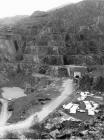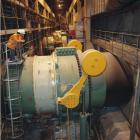Building Electric Mountain
Items in this story:
The Way of Electricity
At the beginning of the 20th century electricity went from being a rare luxury to an everyday necessity. New electric tramways, urban railways, a boom in new housing and industry needs meant a much greater demand for electricity.
Before the 1920s there were only a few small scale hydro-electric schemes providing power to local industries and these were often in remote areas due to the conditions needed for hydro-electric schemes. North Wales with its mountain lakes and high rainfall was ideal for the generation of electricity, but far from the urban centres where the demand was. After the Electricity Supply Act of 1926 established a co-ordinated national electricity grid network (the National Grid), providing links across the country, hydro-electric development grew. The North Wales Electric Power Company subsequently built large scale hydro-electric power stations at Maentwrog and Trawsfynydd between 1926 and 1928, which provided power to the National Grid. As a result of the grid, by 1933, about half the houses in Wales had electricity and industrial processes were freed from using steam power.
In 1948 the electricity supply industry was nationalised and the Central Electricity Authority (CEA) was created. In the same year the Scottish engineer James Williamson who was the foremost expert of his day on hydro-electric generation in the UK was commissioned to carry out a survey of six possible hydro-electric sites in North Wales. Bills to allow these to go ahead were put before parliament in 1952 and 1955. In the debates over the North Wales Hydro-electric Power Bill, 1952, Sir Gerald Nabarro stated that:
“It is the intention of the British Electricity Authority to create in North Wales no fewer than eight major hydro-electricity establishments. They are the extension to the Maentwrog scheme, the extension to the Dolgarrog scheme, a new scheme at Ffestiniog; then, if those three schemes are approved, the British Electricity Authority will proceed with a new major scheme at Rheidol, followed by new schemes at Mawddach and Conway, and, finally, the schemes on Snowdon itself and at Nant Ffrancon.”
In 1957 the Central Electricity Generating Board (CEGB) took over responsibilities from the CEA, and between 1957 and 1963 the first pumped storage hydro-electric power station in Britain was built at Ffestiniog. By this time it was hoped hydro-electric power would complement the less flexible developing nuclear power industry.
The idea of a scheme at Dinorwig was proposed by the CEGB with James Williamson (in association with Binnie & Partners) in 1969. In 1973, a further North Wales Hydro-electric Power Bill sought permission from parliament to construct the power station. The bill was opposed by the North Wales Hydro-Electric Protection Committee - a standing committee established during the 1940s which represented the YHA, conservationist, mountaineering, and ramblers' organisations. They received the support of a number of MPs who made several attempts to block the Bill. The British Mountaineering Council also expressed their fears about the danger to the amenities of the newly created Snowdonia National Park by the proposed scheme: ‘This in our view is another instance of whittling away the essential purposes of National Parks for reasons of material expediency.’ but the campaign was ultimately unsuccessful. The arguments for the bill were too convincing:
‘You have a lake which is not less than 800 feet above the lake below and you turn on the flexible power that is yours—something which is unusual and astonishing. The flexible power involved is such that the machine can go from zero to 1,320 megawatts in ten seconds. It can build up to 1½ million kilowatts to feed into the grid’.
Moving mountains of slate
In 1975 The Alfred McAlpine / Brand / Zschokke engineering consortium were awarded the largest civil engineering works contract given by the UK government at the time and work began on the conversion of the Dinorwig slate quarry at Llanberis, North Wales; a centuries old quarry which had ceased working six years before.
A major part of the work to create the underground power station was the excavation of 16km of underground tunnels, deep below Elidir Mountain. Around 12 million of tons of slate had to be removed to create the massive tunnels and machine halls. Their construction required 1 million tonnes of concrete, 200,000 tonnes of cement and 4,500 tonnes of steel. Around 2000 workers were employed to build the power station and it had been written into the contracts from the start that the major part of the site labour force had to be drawn from the local area. There had been a long and proud history of quarrying and slate mining in the area and there was a great deal of local experience in the working slate of which there are 9 different types at Dinorwig , but the recession of the early 1970s had hit hard and unemployment was high. In the event people living within about 50 miles of the site accounted for 95% of the hourly paid workforce.
Possibly because of this, the construction of the station was welcomed by local people from the outset. As the work proceeded and the project became increasingly well known because of the challenge it was presenting and the achievements being attained, the prestige accorded to the project, and to its work force continued to grow.
Engineering expertise and innovation
The design work for the dams at Dinorwig brought together a wide spread of expertise encompassing engineering geology, soil mechanics, rock mechanics, hydrogeology, engineering geophysics, and glacial process geomorphology. Engineering geological maps were compiled covering each dam site and reservoir basin. These maps, now in common use, where first used at Dinorwig. Another innovation at Dinorwig was the use of a rock mechanics team which combined the efforts of engineers, geologists and technicians, with the support of a site laboratory. This team could analyse and solve problems of rock stability, rock support and rock instrumentation on site as they arose.
“Preserving .. the natural beauty of the district"
The area around Dinorwig is famous for its magnificent views from Nant Peris and Llyn Padarn looking up the valley pass towards the Snowdon Range. The North Wales Hydro Electric Power Act 1973 required the appointment of a landscape consultant to: ‘preserve for the public the natural beauty of the district and to preserve flora and fauna and the geological or physiographical features of special scientific interest.’
Almost all construction was underground, and the remains of the existing slate quarry made it possible to introduce engineering structures unobtrusively. The planting of indigenous trees and shrubs was used to screen, or to focus views and to blend the new works to the valley landscape. It was recognised that the problem with dams in a mountain landscape is that they tend to have a level crest creating a straight line which is seen in contrast to the silhouette of the mountains beyond on each side of it. The dam at Dinorwig has a gentle curve linking the mountains on each side making it very unobtrusive. Other ways that the construction of Dinorwig showed sensitivity to its environment were the burying of outgoing cables for 6 miles and the building of the few administration buildings in local stone from old quarry buildings. The spoil from the excavations, and the heaps of slate waste that had been there before from slate quarrying were tipped into old quarries or into deeper parts of Llyn Peris.
How it works
The power station uses the two lakes - Marchlyn Mawr and Llyn Peris - for its pumped water storage scheme. When power is required, water from Marchlyn Mawr is released down a 3.2km long tunnel through a series of inlet valves, driving six pump-turbines as it passes through a generating chamber on its way to Llyn Peris 500 metres below. Each valve with its massive 16 tonne counterweight, can open in 5 seconds and allow 75,000 litres of water to pass through it every second. The water passing through the valves spins a turbine-pump. The generator then makes electricity for use during the day time and peak periods. At the end of the cycle, off peak electricity is used to drive the generators and convert the turbines into pumps to force the water back to the top lake.
Dinorwig was fully commissioned in 1983 and opened by Prince Charles on 9th May 1984. Externally, all that is visible of the power station is a door on the side of the mountain, ensuring that the surrounding area of outstanding natural beauty in the heart of Snowdonia is not impaired.
The power station is now owned by First Hydro Ltd. who run tours of the site and host the Electric Mountain visitor centre. For more information visit the First Hydro website: http://www.fhc.co.uk/dinorwig.htm
Story contributed by: RCAHMW



